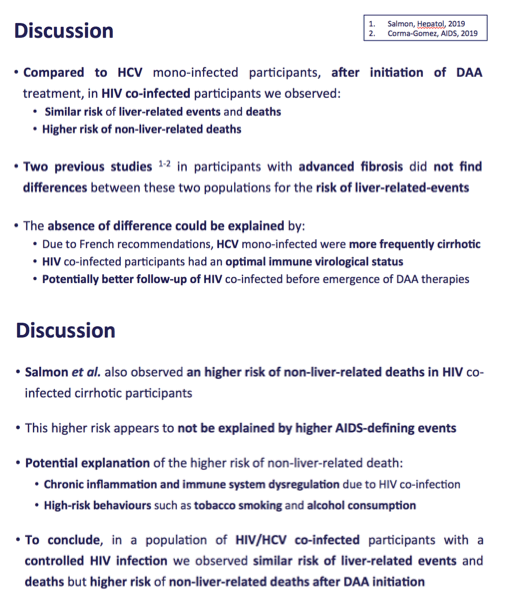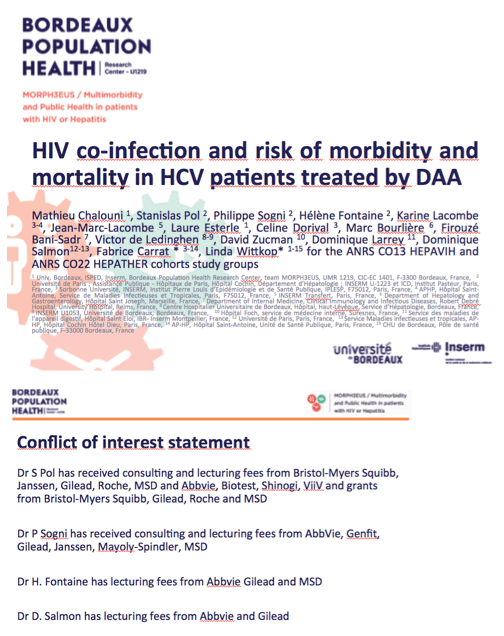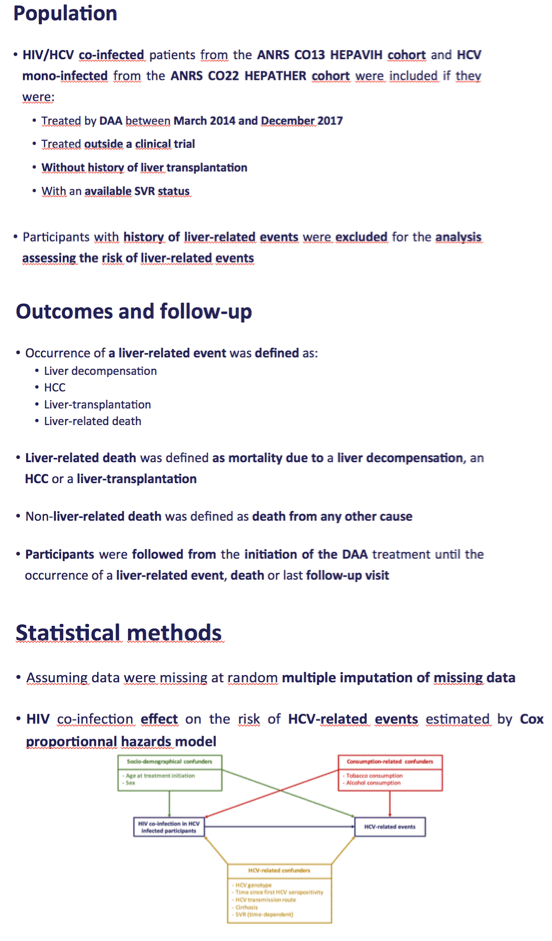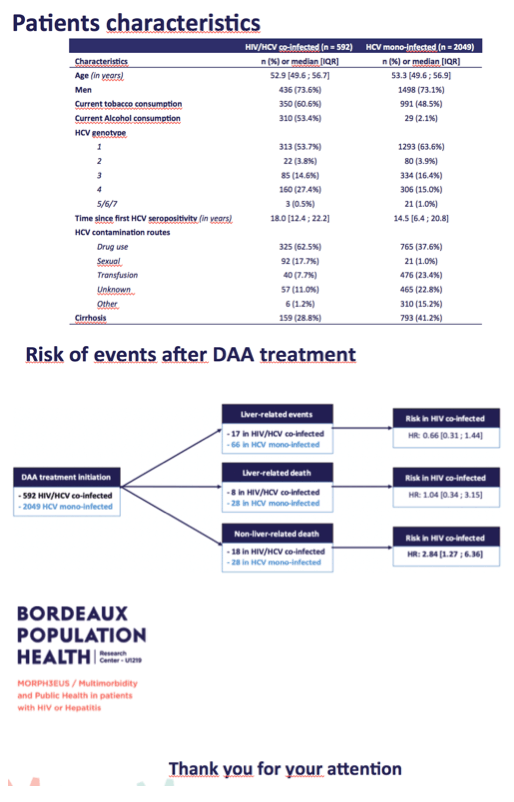 |
 |
 |
| |
HIV co-infection and risk of morbidity and mortality in HCV patients treated by DAA
After DAAs for HCV, Liver Events and Liver Mortality Not Affected by HIV
|
| |
| |
Hospital Admissions, Deaths With HCV Cirrhosis Plunge After DAAs Arrive
EASL 2020, Digital International Liver Congress, August 27-29, 2020
Mark Mascolini
After treatment with direct-acting antivirals (DAAs) for HCV infection, rates of liver-related events and liver-related mortality were similar with or without HIV infection in a large two-cohort comparison in France [1]. But this 2600-person nationwide study found higher nonliver mortality in HCV patients with versus without HIV infection. The peer-reviewed study was published online around the time of EASL 2020 [2].
Before the DAA era, coinfection with HIV increased mortality and hastened liver disease progression in people with HCV. Since 2017 French guidelines have recommended DAAs for all HCV-infected people.
To gauge the impact of DAA therapy on HCV/HIV coinfection, researchers compared HCV-monoinfected participants in the ANRS CO22 HEPATHER cohort with HCV/HIV-coinfected people in the ANRS CO13 HEPAVIH cohort. Participants had to be treated with DAAs outside a clinical trial between March 2014 and December 2017; sustained virologic response (SVR) had to be recorded; and participants could not have had liver transplantation.
The researchers matched participants in the two cohorts for age and sex. Statistical comparisons relied on Cox proportional hazards models adjusted for age, sex, time since HCV diagnosis, HCV infection route, HCV genotype, cirrhosis status, and tobacco and alcohol consumption. The researchers excluded people with a history of liver-related events from the analysis of liver-related event risk.
The study focused on 592 HCV/HIV-coinfected people and 2049 infected only with HCV. The coinfected and monoinfected groups had median ages of 52.9 and 53.3 years, 73.6% and 73.1% were men, 28.8% and 41.2% had cirrhosis, and median times since HCV diagnosis were 18.0 and 14.5 years. Proportions of coinfected and monoinfected people who currently used tobacco were 60.6% and 48.5% and who currently consumed alcohol 53.4% and 2.1%.
DAA combinations used most frequently by coinfected and monoinfected people were sofosbuvir/ledipasvir (48.8% and 34.5%) and sofosbuvir/daclatasvir (32.6% and 31.2%). SVR rates were similar in coinfected people (92.9%) and monoinfected people (94.6%).
After a median follow-up of 2.8 years, incidence of liver-related events in HCV/HIV-coinfected people proved similar to that in people infected only with HCV (12.4 and 13.4 per 1000 person-years, P = 0.78). Liver-related mortality also proved similar with coinfection and monoinfection (5.6 and 4.9 per 1000 person-years, P = 0.76). But nonliver mortality was higher with coinfection (12.5 per 1000 person-years, 95% confidence interval [CI] 7.9 to 19.8) than with HCV monoinfection (4.9 per 1000 person-years, 95% CI 3.4 to 7.1) (P < 0.01).
After adjustment in the proportional hazards model, HCV/HIV coinfection did not affect risk of liver-related events (hazard ratio [HR] 0.66, 95% CI 0.31 to 1.44) or liver-related death (HR 1.04, 95% CI 0.34 to 3.15). But HIV infection independently nearly tripled the risk of nonliver mortality (HR 2.84, 95% CI 1.27 to 6.36).
The ANRS team concludes that HCV/HIV coinfection tends to boost the risk of nonliver-related mortality compared with HCV monoinfection even after treatment with DAAs. They suggested two factors that may explain the higher nonliver death risk in coinfected people: (1) chronic inflammation and immune dysfunction resulting from HIV infection, and (2) higher rates of high-risk behaviors such as smoking and drinking alcohol in people with HIV.
References
1. Chalouni M, Pol S, Sogni P, et al. HIV co-infection and risk of morbidity and mortality in HCV patients treated by DAA. EASL 2020, Digital International Liver Congress, August 27-29, 2020. Abstract AS153.
2. Chalouni M, Pol S, Sogni P, et al. Increased mortality in HIV/HCV-coinfected compared to HCV-monoinfected patients in the DAA era due to non-liver-related death. J Hepatol. 2020:S0168-8278(20)30535-3. doi: 10.1016/j.jhep.2020.08.008.





|
| |
|
 |
 |
|
|